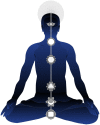Characteristics of Kundalini-Related Sensory, Motor, and Affective Experiences During Tantric Yoga Meditation
- PMID: 35846598
- PMCID: PMC9282169
- DOI: 10.3389/fpsyg.2022.863091
Characteristics of Kundalini-Related Sensory, Motor, and Affective Experiences During Tantric Yoga Meditation
Abstract
Traditional spiritual literature contains rich anecdotal reports of spontaneously arising experiences occurring during meditation practice, but formal investigation of such experiences is limited. Previous work has sometimes related spontaneous experiences to the Indian traditional contemplative concept of kundalini. Historically, descriptions of kundalini come out of Tantric schools of Yoga, where it has been described as a "rising energy" moving within the spinal column up to the brain. Spontaneous meditation experiences have previously been studied within Buddhist and Christian practices and within eclectic groups of contemplative practitioners. Prior explorations of kundalini have emphasized extreme experiences, sometimes having clinical consequences. We conducted a first such investigation of kundalini-related experiences within a sample of meditators from a single Tantric Yoga tradition (known as Ananda Marga) that emphasizes the role of kundalini. We developed a semi-structured questionnaire to conduct an exploratory pilot investigation of spontaneous sensory, motor and affective experiences during meditation practice. In addition to identifying the characteristics of subjective experiences, we measured quantity of meditation, supplemental practices, trait affect and trait mindfulness. We administered it to 80 volunteers at two Ananda Marga retreats. Among reported experiences, we found the highest prevalence for positive mood shifts, followed by motor and then sensory experiences. The frequency of spontaneous experiences was not related to the quantity of practiced meditation or trait measures of mindfulness and affect. Self-reports included multiple descriptions of rising sensations, sometimes being directly called kundalini. Experiences with rising sensations were complex and many included references to positive affect, including ecstatic qualities. There were also reports of spontaneous anomalous experiences. These experiences of rising sensations resemble prior clinical descriptions that were considered kundalini-related. The individuals who reported rising sensations could not be distinguished from other participants based on the incidence of experiences, quantity of meditation practice, or trait measures of mindfulness and affect. In contrast, greater amount of Tantric Yoga meditation practice was associated with greater positive affect, less negative affect and greater mindfulness. Further study of these exploratory findings and how they may be related to spiritual and well-being goals of meditation is warranted along with scientific investigation of purported kundalini phenomena.
Keywords: Ananda Marga; anomalous experiences; contemplative practices; kundalini; meditation; subjective experiences; tantric yoga.
Copyright © 2022 Maxwell and Katyal.
Conflict of interest statement
The authors declare that the research was conducted in the absence of any commercial or financial relationships that could be construed as a potential conflict of interest.
Figures








Similar articles
-
Reducing and deducing the structures of consciousness through meditation.Front Psychol. 2022 Sep 8;13:884512. doi: 10.3389/fpsyg.2022.884512. eCollection 2022. Front Psychol. 2022. PMID: 36160556 Free PMC article. Review.
-
Meditation has stronger relationships with mindfulness, kundalini, and mystical experiences than yoga or prayer.Conscious Cogn. 2015 Sep;35:115-27. doi: 10.1016/j.concog.2015.04.022. Epub 2015 May 22. Conscious Cogn. 2015. PMID: 26002763
-
"Kundalini-like experience as psychopathology: A case series and brief review".Complement Ther Clin Pract. 2021 Feb;42:101285. doi: 10.1016/j.ctcp.2020.101285. Epub 2020 Dec 8. Complement Ther Clin Pract. 2021. PMID: 33360561 Review.
-
Is Trait Mindfulness in College Students Related to Yoga and Meditation Experience?Altern Ther Health Med. 2023 May;29(4):120-127. Altern Ther Health Med. 2023. PMID: 36074970
-
Investigation of the phenomenology, physiology and impact of spiritually transformative experiences - kundalini awakening.Explore (NY). 2021 Nov-Dec;17(6):525-534. doi: 10.1016/j.explore.2020.07.005. Epub 2020 Jul 25. Explore (NY). 2021. PMID: 32753262
Cited by
-
Reducing and deducing the structures of consciousness through meditation.Front Psychol. 2022 Sep 8;13:884512. doi: 10.3389/fpsyg.2022.884512. eCollection 2022. Front Psychol. 2022. PMID: 36160556 Free PMC article. Review.
References
-
- Anandamurti S. S. (1968). “This world and the next,” in Subha’s’ita Sam’graha Part IV. ed. Gupta M. (Ananadanagar, West Bengal, India: Ananda Marga Pracaraka Samgha; ), 74–106.
-
- Anandamurti S. S. (1982). “Shiva in the dhyana mantra,” in Namah Shivaya Shantaya. eds. Ac. Vijayananda Avt. Avtk. Ananda Mitra Ac. Ac. Amitabha Brc. (Tiljala, Calcutta, India: Ananda Marga Pracaraka Samgha; ), 316–326.
LinkOut - more resources
Full Text Sources

